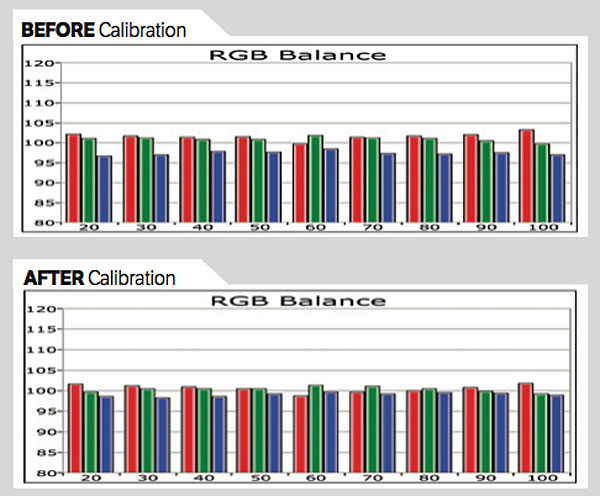Samsung UN60F8000 3D LCD HDTV Test Bench
Full-On/Full-Off Contrast Ratio: 42,800:1
The UN60F8000 was measured at the outset with its default Movie preset/Warm2 color temperature mode selected. Post-calibration measurements were made in Movie mode with adjustments made for dim room viewing. The Samsung switches off its backlight when faced with displaying a 0-IRE (black) signal, so it was necessary to use a 0-IRE test pattern containing a narrow above-black bar in order to make contrast ratio measurements. In Movie mode with the Smart LED control selected, black level measured 0.001 foot-lamberts and my user-selected 42.89 ft-L on a 100-IRE pattern to yield a contrast ratio of 42,800:1. The other two options, Standard and High, yielded similar results. With the Smart LED control switched to Off, black level measured 0.018 ft-L, and a 100-IRE white pattern measured 43.39 ft-L to yield a native contrast ratio of 2,410:1. Maximum brightness in the default Movie mode setting was a whopping 71 ft-L—plenty bright enough that I didn’t even feel a need to make the same measurement in Dynamic mode.

In Movie mode, the set’s gray scale measured slightly warm, averaging 6337 kelvins (K). After calibration using the TV’s two-point White Balance adjustments (10-point is also available), it averaged out to 6444 K, remaining mostly linear except at the extreme top and bottom of the range. The average Delta E of the set’s pre-cal gray scale averaged out to a just-OK 3.34; post-calibration, it averaged out to a more respectable 1.53, with a high of 2.0 at 30 percent brightness. (Delta E is a figure of merit that indicates how closely a display adheres to the Rec. 709 HD color standard. Experts generally agree that levels below 3 are visibly indistinguishable from perfect color tracking.) With its Auto Color Gamut option selected, the Delta E of the set’s color points averaged 1.5—an excellent showing. Post-calibration, it averaged out to around the same. (The adjustments I made in the set’s color management system menu didn’t have much effect outside of leveling off the red luminance.) While gamma with the Movie mode’s default 0 setting selected deviated just slightly from the 2.2 dim room target, the –1 setting provided even more linear results.
Picture uniformity was excellent for an LCD model. I didn’t see any screen clouding, spotlights, or other common LCD uniformity issues on test patterns or regular programs. Off-axis uniformity was also good, with contrast remaining uniform up to more than 15 degrees off center.

The Samsung passed the clipping test from the Spears & Munsil High Definition Benchmark Blu-ray (something that not all LCD displays routinely manage) but got only a marginal pass on the Chroma Multiburst pattern test. It passed all standard- and high-def film and video deinterlacing tests with its Auto 2 Film mode active.—AG








































